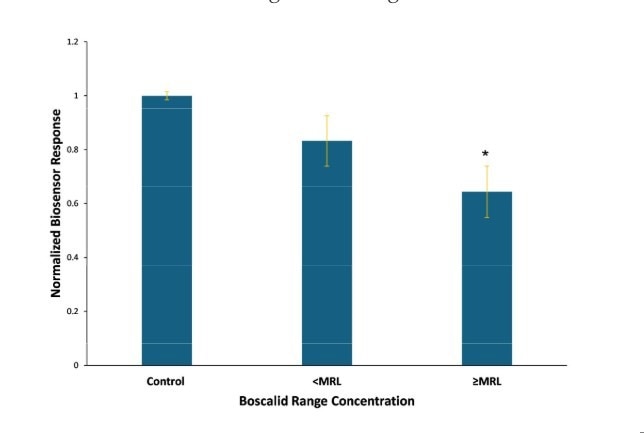In a recent article published in the journal Biosensors, researchers discussed the significance of detecting heavy metals in soils due to their detrimental impact on the environment and human health. It introduces the use of bismuth film along with dsDNA-Modified Electrode Surfaces as a novel approach for accurate analysis of heavy metal concentrations in soil samples.

Cumulative Vero-cell-based sensor responses against boscalid range concentrations above and below MRL, which is 50 ppm for lettuce. Image Credit: https://www.mdpi.com/2079-6374/14/6/311
Background
Heavy metal contamination in soils poses a significant environmental and public health concern worldwide. Urbanization, industrial activities, and agricultural practices have led to the accumulation of heavy metals, such as cadmium, lead, zinc, and copper, in soil matrices. These metals, even at trace levels, can have detrimental effects on ecosystems and human health.
The need for precise and reliable methods to monitor heavy metal concentrations in soil is critical. These methods are essential for assessing contamination levels, identifying pollution sources, and implementing effective remediation strategies.
Traditional analytical techniques often face limitations in sensitivity, selectivity, and cost-effectiveness. In this context, the development of innovative approaches, such as biosensors that utilize bismuth film-modified electrodes and dsDNA modifications, offers a promising solution.
These advanced biosensors could enhance the detection of heavy metals in soil samples, providing more sensitive and selective measurements that are potentially more cost-effective.
The Current Study
In this study, the research team utilized a glassy carbon electrode modified with a bismuth film for the simultaneous voltammetric determination of heavy metal concentrations in soil samples. The preparation of the bismuth film-modified electrode involved several steps to ensure the sensitivity and selectivity of the analysis.
Initially, the glassy carbon electrode was carefully cleaned using a polishing procedure to remove any surface contaminants that could interfere with the electrochemical measurements. Subsequently, the electrode surface was modified by depositing a thin layer of bismuth using a suitable deposition technique. The bismuth film deposition process was optimized to achieve a uniform and stable coating on the electrode surface.
Soil samples from different sources, including natural agricultural soils, urban soils, and artificially contaminated soils, were collected and prepared for analysis. The natural soils were derived from intensively cultivated agricultural areas, while urban soils were obtained from crowded city environments. The artificially contaminated soils were spiked with metal nitrate solutions to achieve elevated concentrations of cadmium, lead, zinc, and copper.
The soil samples were then divided into groups based on their origin and contamination status. The contaminated soils were prepared by mixing metal nitrate solutions with the soil samples through spraying and mechanical agitation. The samples were then transferred to black plastic bags and incubated for a specified period to allow for metal interaction and stabilization.
Analytical measurements were performed using square wave voltammetry to determine the total concentration of cadmium, lead, zinc, and copper in the soil samples. Additionally, the electrochemical biosensor based on dsDNA modification was employed to differentiate the behavior of Cu(I) and Cu(II) in the soil samples, enabling redox copper speciation analysis.
The methodology was validated using a certified reference material (CRM 141R standard soil) to assess the quantification limits and precision of the analysis. The quantification limits for Zn, Cd, Cu, and Pb were determined, and the precision of metal analysis was evaluated to ensure the reliability and accuracy of the proposed analytical approach.
Results and Discussion
The experimental results demonstrated the effectiveness of the bismuth film-modified electrode in simultaneously determining heavy metal concentrations in soil samples. The voltammetric analysis using square wave voltammetry exhibited high sensitivity and selectivity in detecting cadmium, lead, zinc, and copper in various soil matrices.
Quantifying heavy metals in soil samples from diverse sources provided valuable insights into contamination levels and metal distribution in urban, agricultural, and artificially spiked soils. The analytical figures of merit, including quantification limits and precision values, were within acceptable ranges, confirming the reliability and accuracy of the analytical methodology.
The ability to differentiate Cu(I) and Cu(II) behavior using the dsDNA-modified electrode surface introduced a novel approach to redox copper speciation analysis in soil samples. This differentiation is crucial for understanding the bioavailability and environmental impact of copper in soil ecosystems, as different oxidation states of copper exhibit varying reactivity and toxicity.
Comparing the proposed analytical methodology with established techniques underscored the advantages of using bismuth film-modified electrodes for simultaneous heavy metal determination in soils. The eco-friendliness and minimal toxicity of bismuth make bismuth film electrodes a promising alternative to mercury electrodes, offering enhanced sensitivity, selectivity, and overall analytical performance.
Conclusion
In conclusion, the study presents a simple and efficient approach for detecting heavy metals in soils using Bismuth Film and dsDNA-Modified Electrode Surfaces. The findings emphasize the importance of accurate monitoring of heavy metal contamination in soils for environmental and human health protection. The use of biosensors offers a valuable tool for sustainable environmental practices and risk assessment in contaminated areas.
Journal References
Moschopoulou, G., Tsekouras, V., et al. (2024). Development of a Portable Cell-Based Biosensor for the Ultra-Rapid Screening for Boscalid Residues in Lettuce. Biosensors, 14, 311. https://doi.org/10.3390/bios14060311, https://www.mdpi.com/2079-6374/14/6/311